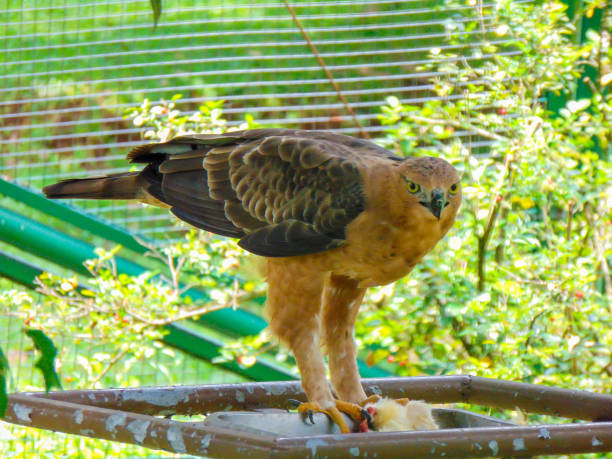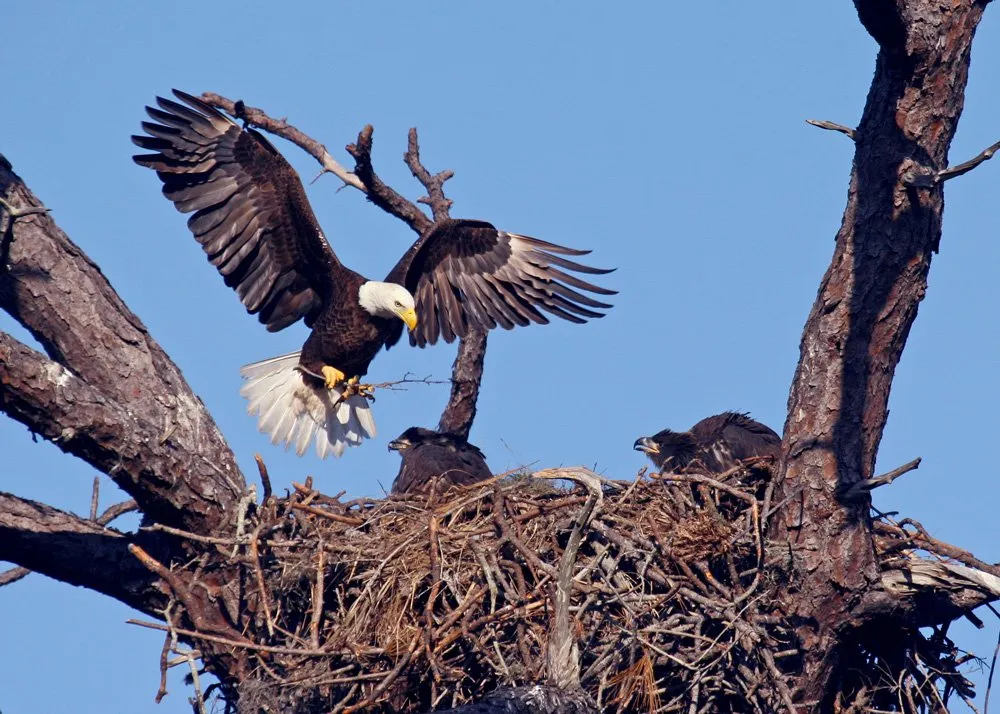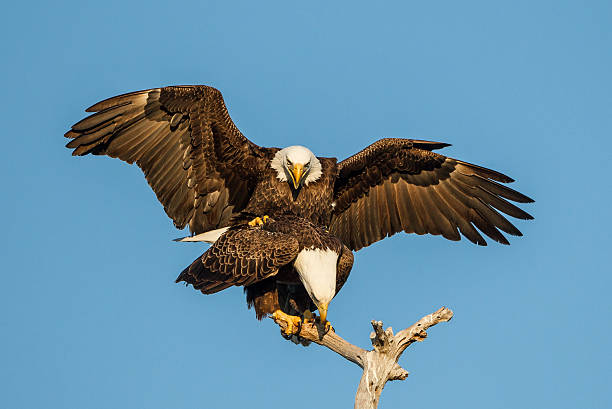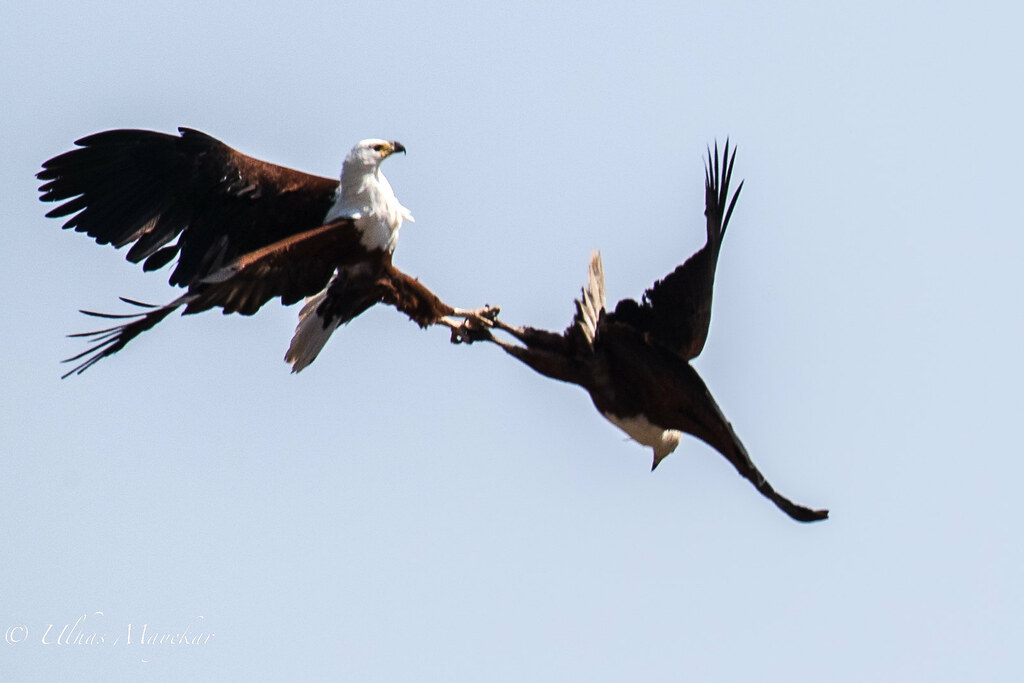Speciality of Eagle: Eagles are majestic raptors that have captivated the human imagination for centuries. As apex predators, these birds exhibit remarkable strength, keen vision, and unmatched hunting abilities. With their massive wingspans and commanding presence, eagles symbolize power, freedom, and precision across many cultures.
Belonging to the genera Aquila and others in the family Accipitridae, eagles are known for their broad wings, hooked beaks, and sharp talons. These adaptations make them formidable hunters, often preying on fish, snakes, birds like pigeons, and even monkeys. Their nesting behaviors, including incubation and brooding, also make them unique among birds.

With a diverse habitat range, from lakes to mountains, and physical traits like impressive wingspans (measured in cm), heavy beaks, and powerful legs, eagles play a critical role in their ecosystems. Their specialized diet and nesting habits, including fledging and chick-rearing, further underline their uniqueness in the avian world.
What Is the Significance of Eagle in Religion?
The eagle has held deep symbolic and spiritual significance across many religions and cultures throughout history. Its majestic flight, powerful vision, and role as a top predator have made it a natural symbol of divinity, power, and freedom. Let’s explore how the eagle is viewed in major world religions and spiritual traditions:
Christianity
In Christianity, the eagle is often associated with renewal, divine inspiration, and spiritual strength. It appears frequently in the Bible. For example:
- Isaiah 40:31 says: “But those who hope in the Lord will renew their strength. They will soar on wings like eagles…”
- The eagle represents St. John the Evangelist, one of the four Gospel writers. His Gospel is seen as the most spiritual and visionary, hence symbolized by the eagle.
- It is seen as a sign of resurrection, ascension, and the soul’s journey toward heaven.
Native American Spirituality
In Native American cultures, the eagle is one of the most sacred animals:
- Considered a messenger of the Creator.
- Eagle feathers are used in ceremonies and rituals for blessings, healing, and prayers.
- The bird symbolizes courage, wisdom, and connection to the divine.
- Among many tribes, spotting an eagle is a powerful spiritual sign of guidance or transformation.
Ancient Egyptian Religion
In ancient Egypt, the eagle (or birds of prey like the falcon) was associated with gods:
- Horus, the sky god, is depicted with a falcon head. Although technically a falcon, many of the traits overlap with eagles: strength, sky, and royalty.
- Eagles were symbolic of the sun god Ra, representing divine rule and watchfulness.
Roman and Greek Mythology
In Greco-Roman religion:
- The eagle was sacred to Zeus (Greek) or Jupiter (Roman), the king of the gods.
- It symbolized divine authority, thunder, and war.
- The eagle would carry Zeus’ lightning bolts, reinforcing its image as a mighty and divine creature.
Hinduism
While not as prominently featured as in other religions, the eagle is represented in Hinduism through Garuda:
- Garuda is a divine bird and mount (vahana) of Lord Vishnu, one of the principal Hindu deities.
- Garuda has the body of a man and the wings and beak of an eagle.
- He symbolizes courage, speed, and the destruction of evil.
Islam
Although the eagle is not directly mentioned in the Quran as a spiritual symbol, in Islamic history and culture:
- The eagle can represent might, vigilance, and leadership.
- Some Islamic empires, such as the Seljuks and Ottomans, used the double-headed eagle on flags and architecture as a symbol of power and divine protection.
Key Takeaways
- Eagles belong to the family Accipitridae and genera like Aquila.
- Known for their keen vision, powerful beaks, and sharp talons.
- Predators that feed on fish, reptiles, monkeys, and birds.
- Display specialized nesting habits including incubation, brooding, and fledging.
- Bald eagles are a famous species, recognized by their white heads.
- Eagles exhibit sexual dimorphism; females are often larger.
- Symbolize strength, power, and freedom in many cultures.
- Thrive in diverse habitats from mountains to lakes.
- Exhibit excellent flying skills and long migration capabilities.
- Play a vital role in controlling prey populations.
Overview of Eagle Genera and Species
The Genus Aquila and Other Genera
Eagles belong to several genera within the Accipitridae family. The most well-known genus is Aquila, which includes the golden eagle. Other genera include Haliaeetus, which includes the iconic bald eagles, and Spizaetus, known for forest-dwelling raptors. These genera vary in size, color, and habitat preferences. Eagles in Aquila are powerful birds that often hunt larger prey. Bald eagles prefer aquatic environments and feed mostly on fish. Understanding eagle genera helps identify their dietary and behavioral speciality of eagle.
| Genus | Notable Species | Habitat | Diet |
|---|---|---|---|
| Aquila | Golden Eagle | Mountains, cliffs | Mammals, birds |
| Haliaeetus | Bald Eagle | Lakes, rivers | Fish, meat |
| Spizaetus | Ornate Hawk-Eagle | Forests | Birds, reptiles |
2. Physical Characteristics: Beak, Feathers, and Legs
Adaptations for Hunting and Survival
Eagles have specialized features that aid them in their predatory lifestyle. Their beaks are large, curved, and sharp, ideal for tearing meat. The beaks vary in color and size but always serve a deadly purpose. Feathers help them remain streamlined in flight and regulate their body temperature. The powerful legs and talons are designed to catch and hold onto prey firmly, from snakes to monkeys. These physical adaptations are crucial for their survival and efficiency as raptors.
| Body Part | Function | Remarkable Feature |
|---|---|---|
| Beak | Tearing meat | Hooked, sharp |
| Feathers | Flight & insulation | Waterproof, layered |
| Legs | Gripping prey | Strong, equipped with talons |
Eagle’s Vision: A Hunter’s Superpower
How Their Eyes Dominate the Skies
Eagles possess exceptional eyesight that surpasses human vision by up to eight times. This keen vision allows them to spot prey from over a kilometer away. The structure of their eyes is adapted to see UV light, giving them an edge when tracking prey like reptiles and fish. Their eyes also enable them to judge distance accurately, an essential trait when diving from great heights during a hunt. This incredible vision is what makes them elite predators.
| Vision Aspect | Description |
|---|---|
| Distance | Up to 3.2 km (2 miles) |
| Color Detection | Includes UV spectrum |
| Focus Ability | Binocular, great depth perception |
Flight Mechanics and Wing Structure
Wingspan, Height, and Flight Style
Eagles are built for flight. Their wingspans can reach over 240 cm, enabling them to soar at great altitudes with minimal effort. Their flight is a combination of flapping and gliding, which conserves energy. They can fly at speeds of 120-160 km/h while diving to catch prey. Eagles rely on thermals (rising warm air) to glide long distances. Their ability to fly at extreme heights makes them effective hunters across varied terrains, from lakes to mountains.
| Wing Feature | Details |
|---|---|
| Wingspan | Up to 240 cm (bald eagle) |
| Flight Speed | Up to 160 km/h |
| Altitude | Over 3,000 meters |
Eagle Nesting Behavior
Nests, Eggs, and Raising Chicks
Eagles build large nests called eyries, often located in tall trees or cliffs. The nests can reach several meters in diameter and are reused year after year. Eagles lay 1–3 eggs per mating season. Incubation typically lasts 35–45 days, during which the female does most of the brooding while the male hunts. After hatching, chicks go through a fledging phase where they grow feathers and prepare to fly. The family unit remains tight during this time.

| Nesting Phase | Time Frame | Role |
|---|---|---|
| Incubation | 35–45 days | Female incubates eggs |
| Brooding | 2–3 weeks | Chicks kept warm |
| Fledging | 10–12 weeks | Chicks learn to fly |
Diet and Hunting Techniques
What Eagles Eat and How They Catch It
Eagles are carnivorous predators with a highly adaptable diet, depending on their species and habitat. Fish-eating eagles like the bald eagle prefer lakes, rivers, and coastal areas where they can catch live fish or scavenge. In contrast, golden eagles residing in mountainous or open areas prey on mammals such as rabbits, rodents, and sometimes monkeys. Some species, like the snake eagle, are specialized in catching reptiles, particularly snakes.

Eagles use their sharp beaks and powerful talons to kill and tear apart their prey. Their digestive systems are adapted to process meat, including bones and fur. In urban settings, eagles may feed on pigeons and roadkill. Their dietary flexibility makes them efficient survivors. They may even cache extra food to consume later. Though they are top-tier raptors, eagles must compete with other birds of prey like hawks for resources.
| Prey Type | Hunting Method | Notable Species |
|---|---|---|
| Fish | Snatch from water surface | Bald Eagle |
| Mammals | Ground ambush | Golden Eagle |
| Birds | Aerial pursuit | Hawk-Eagles |
Reproduction and Mating Rituals
Pair Bonds and Parenting Styles
Eagles often form lifelong mating pairs. Their courtship involves elaborate aerial displays and synchronized flying. Mating generally occurs in early spring, followed by nest building. Once the eggs are laid, the male and female share responsibilities—although the female takes on most of the incubation and brooding. Males provide food during this period. These strong pair bonds ensure that both parents are committed to raising their chicks until they are fully fledged.

INCUBATION, BROODING, and EAGLE Chicks
Eagle reproduction is a detailed and fascinating process that begins with mating rituals. Most eagle species, such as the bald eagle and golden eagle, form monogamous pairs that may last for life. Once mating occurs, the female lays eggs in a massive nest built high in trees or on cliffs. These nests are often reused year after year, growing larger over time. The incubation period generally lasts about 35 days, during which both parents may take turns warming the eggs, though the female does most of the brooding.

After hatching, the young chicks are dependent on their parents for food and warmth. The brooding period ensures the chicks are protected from predators and environmental conditions. As they grow, their feathers begin to form, replacing the soft down. This stage of development is called fledging, and it’s critical to their survival. During this time, eagles feed their young a protein-rich diet including meat from small reptiles, fish, and sometimes even monkeys in tropical habitats. Eagles are extremely protective of their family unit during this period, ensuring that their young reach maturity.
| Eagle Reproduction Milestones | Time Frame / Details |
|---|---|
| Egg Laying | 1–3 eggs per season |
| Incubation Period | Approx. 35 days |
| Brooding Period | 10–15 days of constant warming |
| Fledging Age | 10–12 weeks after hatching |
| Mating Frequency | Usually once per year |
| Reproductive Stage | Description |
|---|---|
| Mating Display | Aerial stunts and calls |
| Nest Building | Both partners participate |
| Parenting Roles | Female incubates, male hunts |
Habitat and Global Distribution
Where Eagles Live and Thrive
Eagles inhabit a wide range of environments including forests, mountains, deserts, and near lakes. Some, like the bald eagle, prefer areas close to water bodies rich in fish. Others like the golden eagle thrive in mountainous terrains. Eagles are found on every continent except Antarctica. Their ability to adapt to different ecosystems has helped them survive and even flourish despite habitat loss in many regions.
| Region | Common Species | Habitat Type |
|---|---|---|
| North America | Bald Eagle | Lakes, rivers |
| Europe & Asia | Golden Eagle | Mountains, cliffs |
| South America | Harpy Eagle | Tropical forests |
Fledging: A Critical Stage in Eagle Development
The fledging stage marks a crucial point in an eagle’s life, transforming from a helpless chick to a confident flier. Around 10 to 12 weeks after hatching, eagle chicks begin to flap their wings, practicing for the first flight. Parents encourage flight readiness by reducing feedings, motivating the young to leave the nest in search of food. The young eagles’ feathers continue to grow during this period, becoming strong enough to support flight and insulation.

At this stage, young eagles are also learning important survival skills, like recognizing prey and avoiding predators. Though they fledge, these juvenile birds may still stay close to their parents for several weeks or even months, learning to hunt, navigate lakes, and recognize habitat boundaries. The beak, wings, and legs continue to strengthen post-fledging, preparing the bird for adult responsibilities. Mastery of flight and independence is not instant—it’s a gradual transition marked by trial, error, and learning.
| Fledging Characteristics | Description |
|---|---|
| Age to Fledge | 10–12 weeks |
| Physical Growth | Full feathers and developed wings |
| Behavior | Wing-flapping, short flights |
| Post-Fledging Dependency | 4–8 weeks learning to hunt |
| Survival Rate | 50–60% make it past first year |
Fun Facts About Eagles
Surprising Details You Might Not Know
Eagles can live up to 30 years in the wild. Their nests, known as eyries, can weigh over a ton due to repeated use and additions. Some eagles have been known to carry prey heavier than themselves. The bald eagle was once endangered but has made a strong comeback. These birds have fewer natural predators due to their size and strength. Eagles also play spiritual roles in indigenous cultures and are national symbols for many countries.
Eagles are more than just powerful birds—they’re packed with intriguing traits that set them apart from the average bird. Did you know that an eagle can carry prey that weighs nearly as much as its own weight? Their legs and talons are designed for this power. Eagles also have more than twice the vision capacity of humans, allowing them to see UV light and spot pigeons, snake, or small fish from miles away.
Interestingly, the largest nest ever recorded belonged to a bald eagle and measured over 2.5 meters wide and weighed more than 1,000 kg! Eagles are also highly territorial and will defend their family and nesting areas fiercely. Their beaks, which grow continuously, must be sharpened and worn down naturally through use. Additionally, in captivity, bald eagles can live over 40 years. These incredible attributes make the eagle a top-tier raptor and a symbol of strength worldwide.
| Fun Fact | Description |
|---|---|
| Eagle Lifespan | Up to 30 years in wild, 40+ in captivity |
| Vision Power | 4–8x sharper than humans |
| Nest Weight | Up to 1,000 kg |
| Prey Carrying Ability | Up to 6–7 kg |
| Beak Growth | Continuous, self-maintaining |
The Future of Eagles: Challenges and Hope
Conservation, Climate, and Public Support
As majestic as they are, eagles face numerous threats in the modern world. Habitat loss due to urban development, agriculture, and deforestation remains a primary concern. Pollution, especially lead poisoning from ammunition in carrion, poses severe health risks. Additionally, collisions with wind turbines and power lines lead to injury or death. Climate change also disrupts traditional migratory routes and nesting seasons, affecting mating and egg hatching success rates.
Despite these challenges, there’s hope. Ongoing conservation programs focus on habitat restoration, legal protections, and community education. In places like the U.S., the recovery of the bald eagle stands as a testament to successful intervention. People are more informed and actively participate in monitoring nests, reporting injuries, and supporting organizations working for raptors. The involvement of youth and educational institutions is also shaping a generation that values bird diversity and ecosystem balance. The future of eagles rests on global collaboration and sustainable choices.
| Threat Factor | Current Conservation Response |
|---|---|
| Habitat Loss | Forest protection, zoning laws |
| Pollution | Lead bans, clean-up efforts |
| Climate Change | Data monitoring, migratory research |
| Power Line Collisions | Design modifications, bird-safe towers |
| Public Awareness | School programs, media campaigns |
FAQs On Speciality of Eagle
1. What makes an eagle different from other birds?
Eagles are powerful raptors known for their sharp beaks, strong legs, large wings, and exceptional vision. Unlike many other birds, eagles can spot prey from several kilometers away and carry animals heavier than themselves. Their diet, hunting techniques, and dominance in the air distinguish them from hawks and other predators.
2. How good is an eagle’s vision?
An eagle’s vision is among the sharpest in the animal kingdom—up to 4 to 8 times better than a human’s. They can detect prey like fish, pigeons, or reptiles from over 3 km away. Their eyes are specially adapted with more light-detecting cells and UV sensitivity.
3. What do eagles eat in the wild?
Eagles have a diverse diet based on their species and habitat. They consume fish, snakes, pigeons, small mammals, and sometimes monkeys. As carnivores, they rely heavily on meat and are skilled at both hunting and scavenging. The bald eagle, for example, prefers fish, while the golden eagle often hunts rabbits and ground animals.
4. Where do eagles build their nests?
Eagles usually build their nests on high cliffs, tall trees, or near lakes for easy access to food. These nests, also called eyries, can reach massive sizes—sometimes over 2 meters in diameter. They reuse and expand the same nest for many years.
5. How long do eagle chicks stay in the nest?
After hatching, eagle chicks stay in the nest for 10 to 12 weeks before entering the fledging stage. During this period, parents provide food, warmth through brooding, and protection from predators. Even after fledging, the young may remain nearby to continue learning survival skills.
6. What is the mating process of eagles like?
Eagles engage in dramatic courtship rituals, including aerial displays and synchronized flight. Once they mate, the female lays 1–3 eggs, which are incubated for about 35 days. Both males and females participate in INCUBATION and BROODING, although females take the lead.
7. What is the difference between bald eagles and golden eagles?
The bald eagle is native to North America and is easily recognized by its white head and tail. It primarily eats fish. The golden eagle, part of the Aquila genus, has brown feathers and is found across the Northern Hemisphere. It preys more on land animals like rabbits, monkeys, and reptiles.
8. How big can eagles get?
Depending on the genera, eagles can reach impressive sizes. For instance, the bald eagle can weigh between 3–6.3 kg and has a wingspan of up to 240 cm. Their height and weight vary across species but they are among the largest birds of prey in the world.
9. How long do eagles live?
In the wild, most eagles live between 20–30 years, depending on species and environmental threats. In captivity, with proper care and diet, they can live up to 40 years. Their longevity is influenced by factors like availability of food, injury, and human interference.
10. Are eagles endangered?
Some eagle species are endangered due to habitat loss, pollution, and climate change. However, thanks to strong conservation efforts, especially for the bald eagle, their numbers are recovering in many regions. Protecting their habitat, reducing lead exposure, and educating the public have helped improve their chances of survival.
Visit: What Is The Specialty of to explore interesting and fun facts about birds, animals, countries and more.
